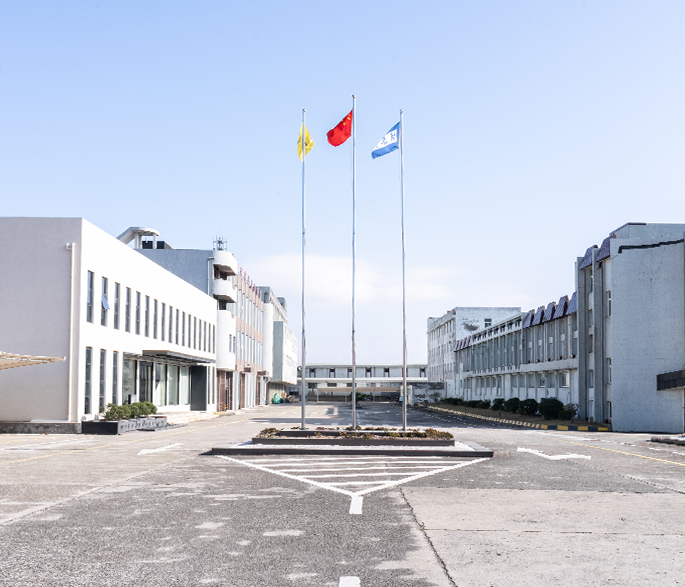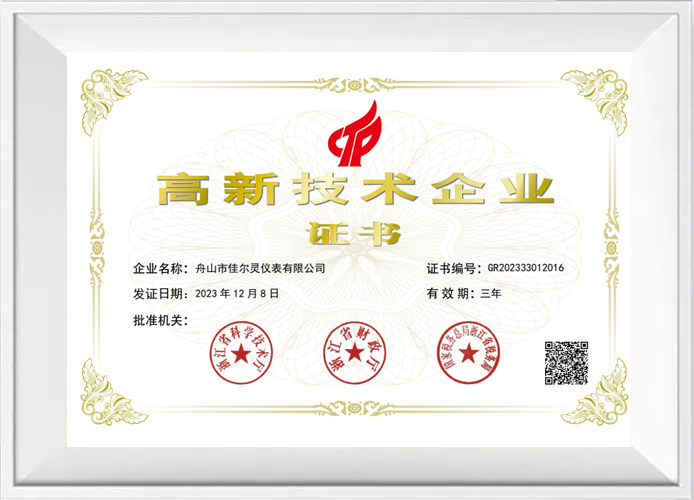Need help? Call us: +86-15105800333 / Whatsapp:+86-15105800333 / Email:[email protected]
- Home
- Product
- About
- Strength
- News
- Contact

Zhoushan Jiaerling Meter Co., Ltd. was established in 2004. It is China Petrochemical Pressure Gauge Manufacturers and Custom Petrochemical Pressure Gauge Suppliers, which is a high-tech enterprise integrating design, research and development, manufacturing, import and export trade.
The company is located in Zhoushan City, Zhejiang Province, covering an area of 15,000 square meters, equipped with a 100,000-level clean workshop, conventional production and assembly workshop, automated production workshop, new laboratory and comprehensive office building.
After more than 20 years of hard work and development, the company has a stable design and development, production team, and advanced production and testing equipment. The company specializes in the production of various types of pressure gauges with complete specifications, and the annual output of pressure gauges reaches 6 million. In order to further develop, the company not only seeks improvement in technology, but also pays more attention to product quality and after-sales service. The company's purpose is to "regard quality as life, survive by reputation, promote development by technology, and serve customers with high-quality brands". The products are sold all over the world and are well received by domestic and foreign customers.
In 2019, the company participated in the compilation of the standard T/CECS10012-2019 "Gas Heating Hot Water Boiler and Water Heater Water Circuit Components" of the China Engineering Construction Standardization Association.
Under the implementation of modern and digital enterprise management, the company has successfully introduced the advanced MES system in 2023, and the order process is fully visualized to track data, ensuring the continuity of production and improving production efficiency.
The company will continue to adhere to the principles of excellence, accuracy, reliability, continuous improvement, and meeting customer needs, hoping to share harmony and prosperity with friends across the country.








In the complex fluid measurements of the petroleum and chemical industries, the accuracy and stabili...
View MoreIn the rigorous environment of the petrochemical industry, the reliability of pressure measuring ins...
View MorePP diaphragm pressure gauges, with their polypropylene (PP) body and corrosion-resistant diaphragm m...
View MoreThe core function of a PP diaphragm pressure gauge, particularly one used in corrosive environments ...
View MoreFour Direct Impacts of an Inaccurate Brewing Pressure Gauge A brew pressure gauge displays the actua...
View MoreIn the petrochemical industry, the accuracy and reliability of pressure measurement are key factors to ensure production safety and efficiency. JRL petrochemical pressure gauges rely on their advanced measurement technology and precision manufacturing process to ensure that the measurement accuracy reaches ±0.5%FS or even higher. This high-precision measurement capability can not only reflect the pressure changes in the production process in real time, but also provide solid data support for production control and fault diagnosis, greatly improving the level of intelligent production operations.
Petrochemical production environments are usually accompanied by high temperature, high pressure and highly corrosive media, which poses severe challenges to the material selection and structural design of pressure gauges. JRL petrochemical pressure gauges use high-performance special alloy materials such as stainless steel and Hastelloy, which have excellent corrosion resistance and can maintain long-term stable operation in extreme environments. In order to further improve the corrosion resistance of the product, JRL's design team has carried out in-depth optimization in structural design and sealing technology to ensure that the pressure gauge shows excellent reliability and durability in harsh petrochemical environments.
Safety is a key factor that cannot be ignored in the petrochemical industry, especially in environments with explosive gases and steam, the safety performance of pressure gauges is particularly important. JRL petrochemical pressure gauge adopts explosion-proof or intrinsically safe structural design, strictly follows international explosion-proof standards, and ensures safe and reliable operation under extreme conditions. This design not only effectively prevents the risk of explosion caused by internal faults or external fire sources, but also significantly improves the applicability of the product in petrochemical environments. In addition, JRL pressure gauges are also equipped with multiple safety protection mechanisms, including overpressure protection and overcurrent protection, which further enhances its safety performance and ensures users' peace of mind and reliability during use.
The installation of petrochemical pressure gauges is an important part of ensuring measurement accuracy and safety. Choosing a suitable installation location, configuring necessary accessories, paying attention to installation details, and conducting subsequent inspections and maintenance are all key factors in ensuring instrument performance.
First of all, the choice of installation location is crucial. The ideal installation location should be easy to observe. Usually, the dial should not be placed horizontally, but should be set at a height and angle that is easy for operators to observe to ensure clear readability of pressure data. At the same time, the connection distance between the pressure gauge and the pressure measuring point should be shortened as much as possible, which can effectively reduce pipeline resistance and measurement errors, ensure good sealing, and thus prevent medium leakage. In addition, avoid installing the pressure gauge in an environment with vibration, shock or drastic temperature changes, which may have a negative impact on the measurement accuracy and service life of the instrument.
Secondly, in terms of the configuration of installation accessories, JRL recommends taking a series of measures to improve the safety and accuracy of petrochemical pressure gauges. Installing a buffer can effectively absorb the pulse pressure and shock in the pipeline, thereby protecting the pressure gauge from damage. At the same time, a shut-off valve is configured under the instrument to quickly cut off the pressure source when necessary, which is convenient for instrument maintenance or replacement. In addition, when the medium is dirty, it is necessary to install a filter to remove impurities and prevent clogging the air inlet of the pressure gauge, thereby affecting the accuracy of the measurement.
Installation details should also not be ignored, as they are directly related to the measurement accuracy and service life of the pressure gauge. First, the pipeline should be thoroughly cleaned before installation to ensure that there are no contaminants such as dust and impurities. At the same time, check whether the pressure gauge pointer is zeroed and whether there is any leakage to confirm that the instrument is in good condition. When connecting, it is necessary to select the appropriate connection method according to the thread standard of the pressure gauge. For tapered pipe threads, mechanical sealing can be performed directly; for straight pipe threads, sealing should be performed by gluing or wrapping raw tape. In a high-pressure environment, it is very necessary to use a gasket to ensure the tightness. The petrochemical pressure gauge should be installed vertically to ensure the accuracy of the measurement results. The pressure gauge should be tightened with a wrench during installation to avoid damage to the case due to excessive twisting. At the same time, adjust the dial to a position that is easy to observe to ensure that the operator can clearly read the pressure data.
Finally, after the installation is completed, necessary inspections and maintenance are important steps to ensure the normal operation of the petrochemical pressure gauge. It is recommended to slowly open the control gate during the pressure test and observe the pressure gauge's pressure to confirm whether the instrument can work properly. Regularly checking the various indicators of the pressure gauge, including whether the pointer is zeroed, whether the scale is clear, and whether the seal is intact, are effective ways to keep the instrument in good condition. In addition, according to the usage and the manufacturer's recommendations, the pressure gauge should be calibrated regularly to ensure that its measurement accuracy meets the requirements.